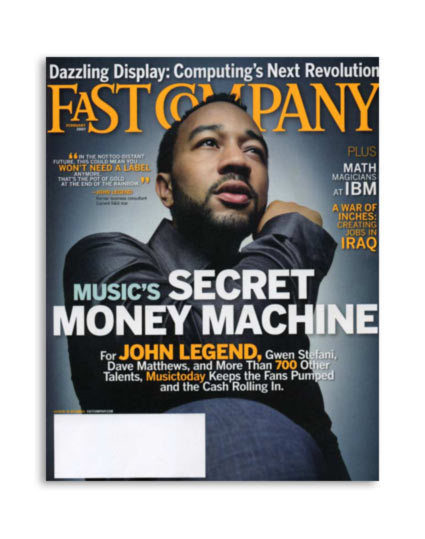24 Ene La experiencia Infonomia, publicada en la sección WorldClass de la prestigiosa revista FastCompany
Tengo la alegría de poder comunicar que la ?experiencia Infonomia? ha sido publicada en la sección Next World Class de la revista FastCompany de febrero de 2007.

Espero que no se enfaden si cuelgo aquí el artículo y que tengan en cuenta que si lo hago es para dar a conocer esta extraordinaria publicación, que ha servido de orientación y referencia a miles de innovadores en todo el mundo. Aquí va, pues, un pdf del artículo en cuestión.
Más aún, me permito incluir la entrevista original que me hicieron, en la que, como se puede ver, me preguntaron de todo, por delante y por detrás, por arriba y por abajo, con el objetivo de entender bien qué, cómo y, sobre todo, por qué hacíamos lo que hacíamos. Aunque lo más sorprendente, para mí, fue que una vez realizada toda la entrevista, me pidieron ejemplos de organizaciones en la que se estuviera utilizando lo que decimos o hacemos, con el fin de contrastarlo todo. Un ejercicio de profesionalidad por el que no puedo menos que felicitarlos.
La historia de FastCompany es, si se me permite, ejemplar de lo que ha ocurrido en innovación en los últimos años.
La conocí, gracias a una alumna norteamericana que me comentó, tras una clase sobre Internet en la escuela de negocios en la que entonces yo trabajaba, hacia 1997, que lo que yo explicaba coincidía bastante con una publicación norteamericana que estaba creando escuela. En efecto, lo comprobé cuando empecé a recibir los primeros ejemplares de la revista, una gruesa publicación, cuyo gran número de páginas, en especial las muchas de extraordinarios anuncios, mostraban el punto álgido de la que después hemos llamado era puntocom.
Entonces aprendí que el fundador de FastCompany, Alan M. Weber, había sido anteriormente editor de la Harvard Business Review, el culmen para un editor de revistas de empresa, y que había dejado esta última para fundar una revista ?en la que poder publicar lo que no podía publicar en la Harvard?.
Desde el primer número, me convertí en un ?fan? de la revista, y busqué en todos sus artículos aquella conexión de ideas tan difícil de encontrar, por entonces, en revistas europeas (al menos en un idioma que yo pudiera comprender).
Poco antes de la debacle puntocom, creo que así fue, Weber y sus socios vendieron la revista a la división de revistas del grupo alemán Bertelsmann AG, editora que, creo poder decir, no supo muy bien como proyectar hacia arriba la revista.
En junio de 2005, tanto FastCompany como Inc, otra interesante revista de empresa, fueron adquiridas por el holding de un conocido emprendedor norteamericano, Joe Mansueto, que hizo una gran fortuna con la publicación (servicio de rating) sobre finanzas Morningstar. En el primer número de la nueva época, Mansueto desvelaba por qué había comprado Inc y FastCompany; porque le habían servido con buenas ideas en su trabajo como emprendedor, y que, agradecido, quería que otros emprendedores se aprovecharan de esta fuente de ideas.
Al parecer, la revista perdió dinero en 2005, y se preveía que también lo hiciera en 2006… básicamente a causa de la caída de publicidad que experimentan los medios en papel en todo el mundo avanzado. Son tiempos difíciles para la prensa en papel…
Pero la historia de FastCompany sigue progresando, manteniendo cuatro principios que encontramos en su página About:
Fast Company has always been about innovative people and ideas. Our mission is to find the creative workers and organizations that are building the future, and to present their stories in smart, compelling, beautiful, and useful ways. This mission is the core of the magazine’s original DNA; it’s the brilliant bit that differentiates us from all the other business magazines out there.
We’re not about stock performance, we’re not about business news, we’re not about corporate strategies to increase next quarter’s earnings per share by a few pennies. We offer the insights business readers most hunger for: what it takes to create new products, new services, and new ways of doing business. Whether it’s a wholly new design (think iPod) or a business-model innovation (think Netflix) these are the imaginative leaps that allow people and companies to break free of the business world’s equivalent of trench warfare — grinding competition on cost or incremental features. They’re how real winners are born, how real money is made, how things of beauty and usefulness are created, how consumers’ lives are enriched and society made better, and how America must compete in this world.
Each of the adjectives I used above — smart, compelling, beautiful, and useful — addresses an essential element of every Fast Company story:
Smart, because we live in a tough, complex world. Through rigorous and thorough reporting, we find out what’s really going on in a company, a business, a technology, a design effort. We examine ideas critically. We show that the people and ideas we write about have real impact, and produce real profits. Sometimes we explore instructive failures.
Compelling, because good story-telling is absolutely essential. The techniques may be different — profiles, narratives, multipart packages — but we always strive to humanize our stories, to present creative ideas through stories of real people addressing and surmounting real challenges. Business is dramatic, exciting, and inspiring. So are the best business stories.
Beautiful, because cutting-edge design is another essential part of Fast Company’s DNA. A magazine that is about creativity, and one that espouses the primacy of design, must itself embody the best in creative design. Just as we present design as a way of thinking about and solving problems, our own design is beauty with a purpose: Our pages work seamlessly with the stories to convey meaning.
Useful, because ultimately that’s why you come to us. Every story in the magazine has some element of utility, some lesson, example, insight, or bit of information you can gain from, and can at least think about applying to your own circumstances. There is, I believe, no more compelling, no more useful story in business journalism than the chronicle of creative people taking risks for the sake of doing something new, bold, and profitable. If you’re in a business that thirsts for innovation in order to stay ahead of fast-moving technology, changing consumer patterns, and rising competition — and who isn’t? — Fast Company is for you.
Bueno, Infonomia quiere estar en esta liga, y por ello lanzará el próximo mes el número 50 de su revista ?if…?, con un nuevo formato y un contenido más inteligente, llamativo, bonito y útil…



Sorry, the comment form is closed at this time.